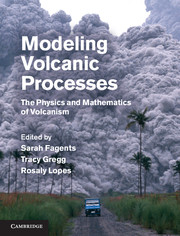Book contents
- Frontmatter
- Contents
- Contributors
- Chapter 1 Introduction
- Chapter 2 Magma chamber dynamics and thermodynamics
- Chapter 3 The dynamics of dike propagation
- Chapter 4 Dynamics of magma ascent in the volcanic conduit
- Chapter 5 Lava flows
- Chapter 6 Unsteady explosive activity
- Chapter 7 Unsteady explosive activity
- Chapter 8 Sustained explosive activity
- Chapter 9 Modeling tephra sedimentation from volcanic plumes
- Chapter 10 Pyroclastic density currents
- Chapter 11 Magma–water interactions
- Chapter 12 Deep-sea eruptions
- Chapter 13 Volcano–ice interactions
- Chapter 14 Modeling lahar behavior and hazards
- Chapter 15 Introduction to quantitative volcano seismology
- Chapter 16 Volcano acoustics
- Chapter 17 Planetary volcanism
- Index
- Plate section
- References
Chapter 15 - Introduction to quantitative volcano seismology
Fluid-driven sources
Published online by Cambridge University Press: 05 March 2013
- Frontmatter
- Contents
- Contributors
- Chapter 1 Introduction
- Chapter 2 Magma chamber dynamics and thermodynamics
- Chapter 3 The dynamics of dike propagation
- Chapter 4 Dynamics of magma ascent in the volcanic conduit
- Chapter 5 Lava flows
- Chapter 6 Unsteady explosive activity
- Chapter 7 Unsteady explosive activity
- Chapter 8 Sustained explosive activity
- Chapter 9 Modeling tephra sedimentation from volcanic plumes
- Chapter 10 Pyroclastic density currents
- Chapter 11 Magma–water interactions
- Chapter 12 Deep-sea eruptions
- Chapter 13 Volcano–ice interactions
- Chapter 14 Modeling lahar behavior and hazards
- Chapter 15 Introduction to quantitative volcano seismology
- Chapter 16 Volcano acoustics
- Chapter 17 Planetary volcanism
- Index
- Plate section
- References
Summary
Overview
Recent technological developments and increases in the seismological instrumentation of volcanoes now allow the surface effects of subterranean volcanic processes to be imaged in unprecedented detail. The wealth and accuracy of resulting seismic data have allowed the identification of oscillatory behaviors that are intimately related to magma transport dynamics. A critically important area of research in volcano seismology today is aimed at the quantification of the source properties of these oscillatory signals, which typically include Long-Period (LP) events and tremor with periods in the range 0.2−2 s, and Very-Long-Period (VLP) events with periods in the range 2−100 s (see Glossary at end of chapter). The two types of events provide information about the seismic source geometry, fluid properties at the source, and source excitation process, all of which represent critical elements in the assessment of volcanic behavior and associated hazards. To fully exploit the potential of seismic observations, however, we must learn how to translate seismic source mechanisms into quantitative information about fluid dynamics, and we also must determine the underlying physics that governs vesiculation, fragmentation, and the collapse of bubble-rich suspensions to form separate melt and vapor. Refined understanding of such processes requires multidisciplinary research involving detailed field measurements, coupled with laboratory experiments and numerical modeling.
- Type
- Chapter
- Information
- Modeling Volcanic ProcessesThe Physics and Mathematics of Volcanism, pp. 331 - 358Publisher: Cambridge University PressPrint publication year: 2013
References
- 1
- Cited by



